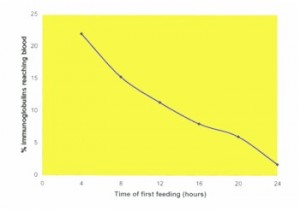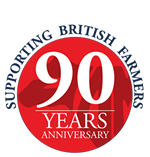Relevant Products
- Jameson IMMU-Surge calf milk replacer (PDF)
- Jameson IMMU-Power calf milk replacer (PDF)
- Jameson IMMU-Gain calf tubes (PDF)
- ProviMilk Daisy
- Calf weaner pellets (PDF)
- Premium coarse mix (PDF)
Calf rearing is an important job on the farm. Remember the young calf is the future of your herd. Well reared, healthy calves will produce high yielding, healthy adult cattle.
Colostrum intake
Colostrum intake within the first 24 hours after birth provides a calf with the essential antibodie (immunoglobulins) needed to help fight disease and infection at such a vulnerable stage of its life. Immunity to diseases will pass to the calf from the cow, particularly if she has been vaccinated against diseases such as rotavirus. Good colostrum management at birth is key to helping avoid poor health, low growth rate and high mortality in calves. A good quality of colostrum should also contain fat (a laxative and energy source), and high levels of vitamins A, D and E.
A calf’s gut can only absorb colostrum between the first three and 24 hours of its life, so feeding good quality colostrum at the right time and in right quantity is essential. As a rule, a calf fed three litres of colostrum over two feeds within three to six hours of birth will have received sufficient to fight against many of the most common illnesses.
Time of feeding and immunoglobulin absorption
Colostrum is naturally available from the dam, but it may become necessary to either supplement or replace the dam’s colostrum with a commercial substitute, due to colostrum deficiencies that often exist in the dam, particularly in high yielding Holstein cattle.
Bought-in calves
It is probably wise to purchase calves no younger than 2 weeks old as this can reduce the likelihood of E.coliand Salmonella scours, (typically 0 – 4 days old) and rotavirus and coronavirus infections. Also, navel ill, hernias, and heart defects tend to show up within one week of age as do congenital conditions. Also, calves that haven’t received colostrum should have shown up and can be avoided.
Causes of Calf Scour
Housing and management
Calves should arrive to deep bedded straw yards that have been thoroughly cleaned and disinfected. Calves should have access to clean water at all times; this will aid digestion and rumen function. Calves will drink around 4.5 litres of water per day and in addition to maintenance requirements this will aid digestion and rumen function. They will need to rest on arrival and should only have access to water at this time.
Buildings should be well ventilated without being draughty to avoid pneumonia.
Calf milk replacer (CMR)
The cost per unit of milk replacer tends to be less than that of whole milk; CMR is generally the most cost effective way of feeding batches of calves.
Feeding waste milk to calves may cause infection to spread from your herd to your calves, for example Johne’s disease, BVD, Staph and E. coli. Performance of calves may suffer as waste milk may not be as nutritious as calf milk replacer and may vary in nutritional composition throughout the year. Also, changing the calves between waste milk and calf and milk replacer will unsettle the gut and lead to scour. If waste milk contains antibiotics, resistance to antibiotics can develop in the calves.
Skim and non-skim (whey) based calf milk replacer
The two main categories of CMR are termed skim based and non-skim (whey) based.
Good quality skim based milk replacers contain 50 – 60 % skimmed milk powder. The protein within the reconstituted milk forms a clot in the calf’s stomach, slowing its release which in turn reduces the risk of digestive upsets and minimises the incidence of scour. Acidified versions of skim milk replacers have been shown to further reduce the incidence of scour. Skimmed milk powders suit bucket and machine feeding systems.
Zero skim milk replacers contain whey and whey protein based concentrates along with some soybean or other vegetable proteins (should not be in too high quantities as they are cheaper, less effective ingredients). This type of milk replacer can give similar levels of performance compared to skimmed milk powders and in some situations is more cost effective. Zero skim milk replacers do not form a clot in the calf’s stomach. As a result there is a risk of overloading the calf’s small intestine if this replacer is fed infrequently. Therefore care should be exercised to avoid overfeeding this type of replacer on a twice a day feeding system to calves under four weeks of age.
It is now common to see whey based CMRs being used which also contain some skimmed milk powder along with soya and wheat proteins, egg powder, gut enhancers, vitamins and minerals. Nutritional values are comparable to those of skim based CMRs, while prices are generally lower. A range of different CMRs are available to suit twice a day and computerized feeding regimes.
Feed four feeds 2 litres a day at first and then move up to eight feeds 4 litres (or 5 litres for dairy heifers). A little and often approach can be achieved by splitting the feeds into smaller meals, this will lead to fewer problems with scouring. In addition, calves will start eating concentrate and straw earlier. Rumen development and function will be sooner than conventional systems.
Feeds and roughage
There are a range of dry feed options available. As a guide a good benchmark for dry feedstuffs might be as follows:
- starter pellets – 4.5% oil, 18% protein, 7.5% fibre and 7% ash
- coarse calf mix – 3% oil, 18% protein, 7% fibre and 7.5% ash
Hay should be avoided as this doesn’t aid rumen development as well physically as straw also, its fermentation in the gut can be deleterious to food intake. The sooner the rumen begins to function effectively, the better the calves will perform, and feed costs will be minimised. To maximize input early on, a palatable, high protein coarse mix should be offered ad libitum and any rejects cleaned out everyday.
Weaning
Weaning generally takes place when calves reach a live weight of between 63kg and 80kg and are eating around 1kg of concentrates per day. This stage is normally reached at five weeks on the system for bought-in calves or seven to eight weeks for calves on farm. The calf’s intake of milk can be reduced gradually over a week so as to encourage it to consume more concentrates and not upset the fine balances of the gut.
Hygiene
Strict hygiene measures will help to prevent disease, calf pneumonia can be minimised by cleaning out housing at between 4 and 5 weeks to reduce ammonia levels. Calves should be bedded daily with fresh, clean straw to stop cross-contamination. Pressure washing and disinfecting buildings as well as the periodic resting of facilities will also prevent disease build up. It is wise to dose calves to prevent coccidiosis, as research has shown that young stock infected at two months of age show reduced growth performance thereafter. Feeding equipment needs to be kept scrupulously clean; this will prevent transmission of diseases such as cryptosporidia.
Calves should grow at between 0.65kg and 0.75kg per day and should weigh between 100kg and 125kg at 12 week.




